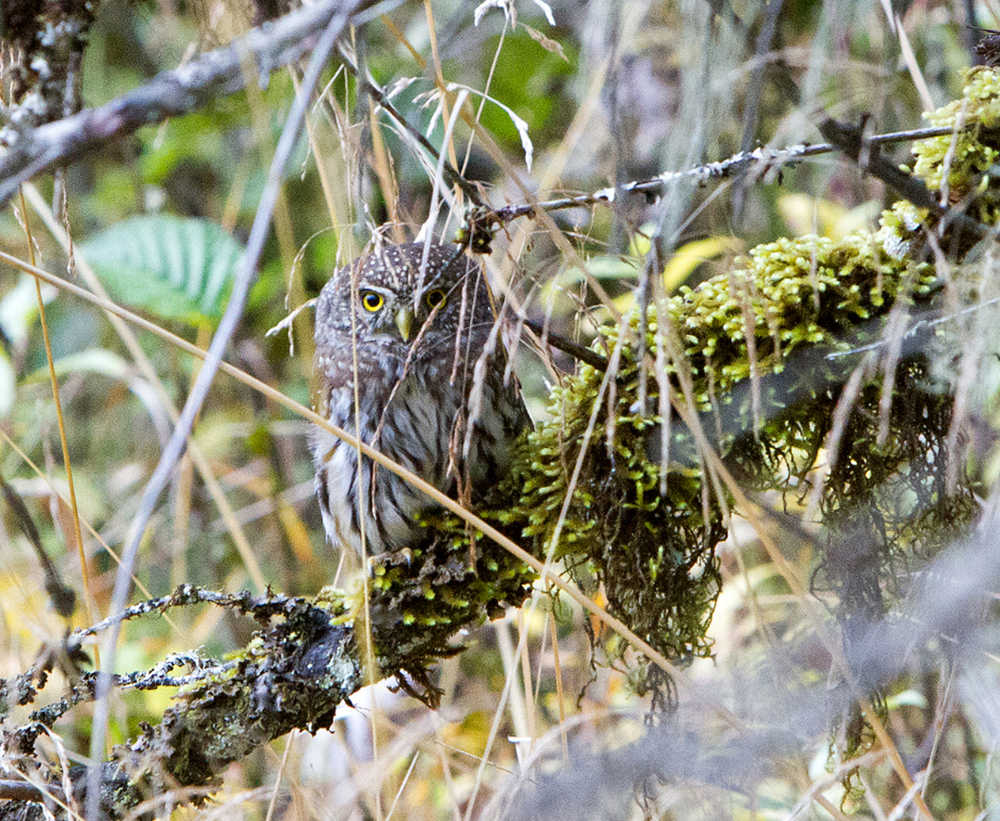In the meadows near Cowee Creek, a few late flowers bloomed. Salmon carcasses littered the mudflats and creek bank. High-bush cranberry shrubs were decorated with bright red berries.
As friends and I slogged through the wet meadows, thinking about the possibility of bears in the area, we noticed something odd: a dead branch suddenly moved along the forest edge, about six feet off the ground. Oooops, the ‘branch’ was attached to a large brown creature–not a branch, of course, but moose antlers! This one bore a small set of antlers, and he was accompanied by a female. They moved off, very gracefully, into the edge of the forest. Aha—a consorting pair—it’s the mating season. Moose are seldom seen along our road system, but this year there have been several reports of moose in the general area of Echo Cove.
A week or two later, we revisited this area, and this time the chief interest lay in what was recorded in the mud: Tracks of otter and mink along the creek, large tracks of moose and smaller ones of an adult deer in the trail. Best of all was the footprint of a brown bear heading south and, on top of it, a tiny track of a deer fawn, heading north.
The area around Steep Creek usually offers some interesting observations. In early October, the female black bear known as Nicky was seen on several occasions ambling peaceably along the creek, looking increasingly prosperous. She is accustomed to the presence of people (as long as the people behave well) and calmly does her bear-things. The coho were starting to come in, and so Nicky should become even more rotund. In the bear world, fat mamas are good mamas, because the fat stores fuel lactation and successful cub development. We are hoping Nicky will have a cub or two, next spring.
As we stood in the road, checking out a few fish in the stream (and counting speeding vehicles, all of which ignored the speed limits), a small bird fluttered across the road and landed on a low branch in the brush. A strange manner of flying, and unexpected white marks on the plumage. What could it be? We crept close and finally spotted the tiny, immobile bird—nearly invisible. A northern pygmy owl! Then we heard the familiar, whistled ‘tu-tu-tu-tu’ coming from up in a cottonwood, and another one flew across the road. Although pygmy owls are not uncommon here, I don’t see or hear them very often, so this was a treat.
Pygmy owls are not the smallest of owls, but they are indeed small, only six or seven inches long from tip to tail, and weighing roughly two ounces. They forage mostly on small mammals, birds, insects, and sometimes reptiles, and occasionally raid bird nests. They can kill and carry off prey larger than themselves. Unlike many other owls, they hunt primarily by eyesight rather than hearing, and often forage in the daylight hours.
Fierce little predators, they are, and I got a first-hand idea of just how fierce years ago when I studied Chilean forest birds. We had set up a line of mist nets to capture (and release) small birds as one means of assessing the diversity of birds in a certain site. When we checked the nets, we noticed that several birds had been caught, and right next to a small songbird was a southern pygmy owl (very similar in looks, sound, and behavior to our northern species). I carefully extracted the owl from the net. Its talons promptly clamped onto my hand authoritatively, and soon red streaks were running down to my wrist. After a photo was taken, I released the owl and, undeterred by its own capture, it flew straightaway into the next net after another captured songbird.
Indomitable! No stopping that one!
• Mary F. Willson is a retired professor of ecology.

